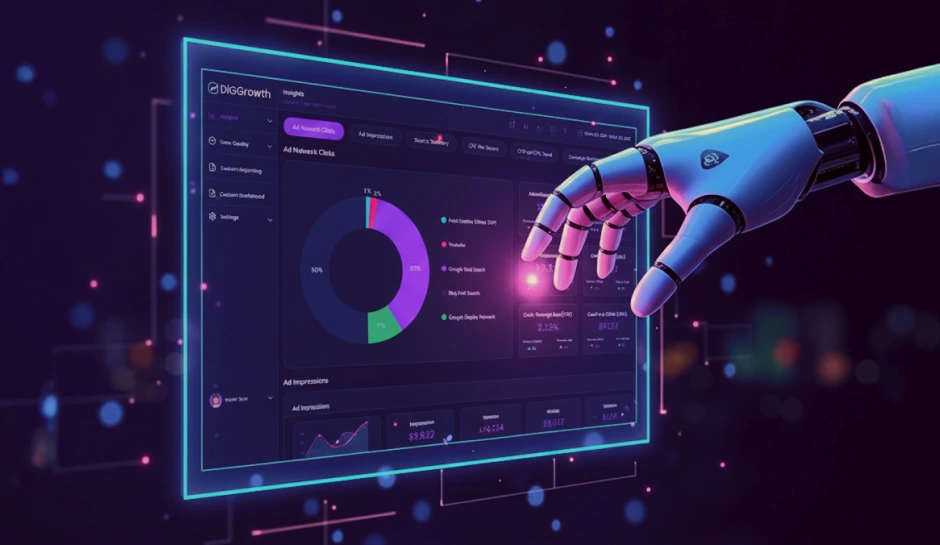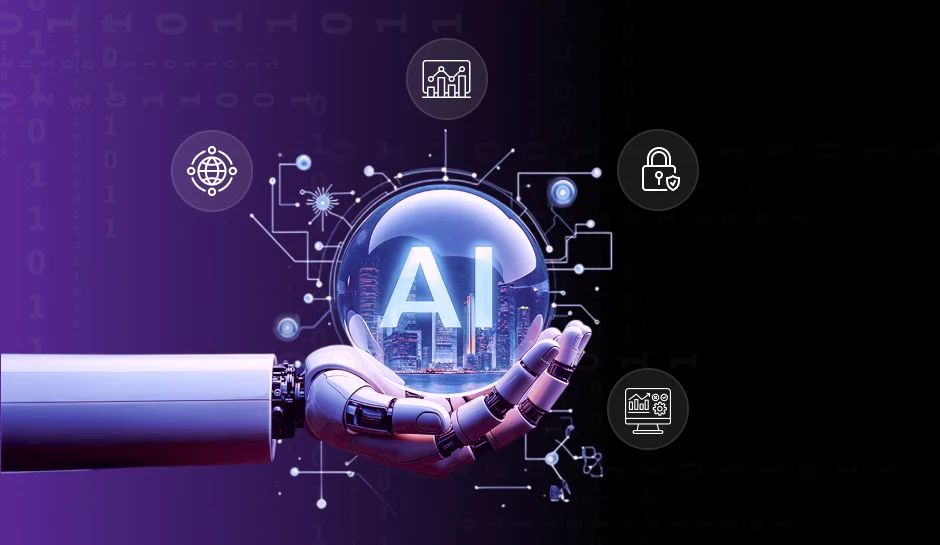
AI-Powered Account Targeting in ABM: Precision Marketing for B2B Success
Targeting the right accounts is critical for ABM success, but traditional methods often lead to inefficiencies. AI-powered account targeting uses real-time data, predictive analytics, and intent signals to refine audience selection, ensuring marketing and sales efforts focus on the most promising prospects. Read on.
Precision is the foundation of account-based marketing. Yet, many businesses still depend on outdated methods like manual segmentation and static customer profiles. These traditional approaches often lead to wasted resources, lower engagement rates, and missed revenue opportunities.
AI account targeting in ABM is changing how companies identify and engage high-value accounts. Instead of relying on historical data and assumptions, artificial intelligence processes vast amounts of real-time information to predict intent, refine targeting, and ensure marketing and sales teams focus on accounts with the highest conversion potential.
This is not just about improving efficiency. It is about making smarter decisions, engaging prospects at the right time, and creating highly personalized experiences that drive measurable results. Businesses that integrate artificial intelligence into their account-based marketing strategies are not just adapting to change; they are setting a new standard for precision and growth.
This blog will explore how AI account targeting in ABM works, why it delivers better results, and how to implement it effectively to increase revenue and improve customer engagement.
The Role of Artificial Intelligence (AI) in Marketing
AI’s Influence on Modern Marketing Strategies
Artificial intelligence drives efficiency, personalization, and automation in marketing. Businesses use AI to process vast datasets, uncover trends, and refine audience segmentation. Predictive modeling, real-time analytics, and machine learning algorithms help marketers make data-backed decisions. AI-powered tools streamline campaign execution, optimizing channel selection and engagement timing.
Companies integrate AI into email marketing, paid advertising, and customer experience management. AI-driven chatbots enhance responsiveness, while automated content generation scales personalization. Martech solutions leverage AI to orchestrate omnichannel strategies, ensuring cohesive brand messaging.
Connecting AI and Data for Deeper Customer Insights
AI analyzes structured and unstructured data from multiple sources, identifying behavioral patterns. Advanced machine learning algorithms cluster customers based on purchase history, browsing behavior, and engagement signals. Real-time data processing enables micro-segmentation, allowing brands to tailor outreach with precision.
Natural language processing (NLP) deciphers sentiment from customer interactions, improving response strategies. AI’s ability to synthesize first-party, third-party, and intent data ensures a holistic understanding of target accounts. This data-driven approach strengthens predictive accuracy, reducing marketing inefficiencies.
What is AI Account Targeting in ABM?
AI account targeting in ABM is the process of using artificial intelligence to identify, score, and prioritize high-value accounts based on real-time data, predictive analytics, and behavioral insights. Instead of relying solely on static firmographic data or manual selection, AI refines targeting with precision, ensuring that marketing and sales teams focus on accounts that are most likely to convert.
How AI Identifies, Scores, and Prioritizes High-Value Accounts
- Data Aggregation and Analysis:
- Predictive Scoring:
- Behavioral and Intent-Based Targeting:
- Real-Time Adaptation:
AI processes vast amounts of structured and unstructured data from multiple sources, including website interactions, intent signals, CRM records, and third-party data providers. This comprehensive analysis helps build a more accurate and dynamic ideal customer profile.
AI assigns a predictive score to each account based on engagement patterns, firmographic fit, and historical conversion data. This ensures that only the most promising accounts receive priority, reducing wasted efforts on low-potential leads.
AI continuously monitors digital signals such as content consumption, product research activity, and competitor comparisons. These insights allow teams to engage with accounts at the right time, increasing the chances of conversion.
Unlike traditional ABM strategies, AI dynamically adjusts targeting based on evolving account behaviors. If an account’s engagement level changes, AI recalibrates its priority, ensuring that marketing and sales teams act on the most relevant opportunities.
How AI Differs from Manual Targeting in ABM
| Aspect | Manual Targeting | AI-Powered Targeting |
| Data Processing | Relies on static lists and firmographic data | Analyzes real-time behavioral, intent, and firmographic data |
| Account Scoring | Based on assumptions and historical data | Uses predictive analytics to rank accounts dynamically |
| Personalization | Generic messaging based on broad segmentation | Hyper-personalized outreach tailored to account behavior |
| Adaptability | Requires manual updates and re-evaluation | Continuously refines targeting based on live insights |
| Efficiency | Time-consuming and labor-intensive | Scales effortlessly with automation and AI-driven insights |
AI-powered account targeting eliminates inefficiencies, allowing businesses to engage the right accounts at the right time with the right message. This data-driven approach not only improves conversion rates but also accelerates the sales cycle by focusing efforts where they will have the highest impact.
Key Benefits of AI Account Targeting in ABM
AI-driven account targeting is transforming how businesses approach ABM by eliminating guesswork and enabling data-backed decisions. Companies that integrate artificial intelligence into their targeting strategy gain a competitive edge by identifying the right accounts faster, engaging them more effectively, and scaling their efforts without sacrificing precision.
1. Increased Accuracy: AI Refines Ideal Customer Profiles Beyond Traditional Demographics
Traditional account targeting often relies on basic firmographic data like company size, industry, and revenue. While these factors provide a starting point, they fail to capture deeper insights into an account’s actual intent and buying readiness.
AI refines the Ideal Customer Profile (ICP) by analyzing a wide range of data points, including:
- Behavioral signals such as content consumption and digital engagement patterns.
- Technographic data revealing the tools and software a company is using.
- Firmographic and psychographic insights that go beyond static attributes to understand how businesses operate and make purchasing decisions.
By continuously learning from past conversions and market trends, AI ensures that targeting is always aligned with the most promising opportunities.
2. Faster Decision-Making: Real-Time Insights Enable Dynamic Account Selection
Manually updating target account lists is a slow and inefficient process that often results in missed opportunities. AI-driven targeting eliminates this bottleneck by:
- Processing real-time intent data to detect when accounts show increased buying interest.
- Automatically prioritizing high-value prospects based on engagement levels.
- Providing immediate recommendations to marketing and sales teams, ensuring outreach happens at the optimal time.
With AI, businesses no longer have to wait for quarterly reviews or static reports to adjust their strategy. They can act on real-time signals, significantly increasing the chances of converting high-value accounts.
3. Scalability: AI Processes Vast Datasets to Uncover Hidden Opportunities
Scaling an ABM strategy manually is a challenge. The more accounts a business targets, the harder it becomes to maintain precision and efficiency. AI solves this problem by:
- Analyzing thousands of accounts simultaneously without human limitations.
- Identifying lookalike accounts that match the characteristics of existing high-value customers.
- Predicting emerging opportunities based on evolving market trends.
Instead of limiting outreach to a predefined list of accounts, AI expands targeting efforts to include high-potential prospects that might have otherwise been overlooked.
4. Better Personalization: AI Enhances Message Relevance for Each Account
Personalization is at the core of ABM, but generic messaging fails to capture the attention of decision-makers. AI elevates personalization by:
- Tailoring content recommendations based on an account’s past interactions and interests.
- Adjusting messaging dynamically depending on where an account is in the buying journey.
- Delivering hyper-personalized outreach that speaks directly to an account’s pain points and needs.
By aligning messaging with real-time intent signals, AI ensures that engagement is relevant, timely, and impactful, leading to higher response rates and deeper relationships with target accounts.
AI-Powered Techniques for Account Targeting
AI does more than just automate account selection. It applies advanced data-driven techniques to predict, analyze, and adapt real-time targeting strategies. This ensures that marketing and sales teams focus on the accounts most likely to be converted.
1. Predictive Analytics: Identifying Accounts with the Highest Conversion Potential
Predictive analytics uses machine learning and historical data to determine which accounts are most likely to convert. Instead of relying on assumptions, AI evaluates thousands of data points to rank accounts based on their likelihood to engage and buy.
- AI analyzes past customer interactions, deal cycles, and conversion patterns to recognize key attributes of successful accounts.
- It assigns predictive scores to each account, prioritizing those most likely to move through the sales funnel.
- AI continuously refines these scores based on new engagement data, ensuring businesses always focus on the right accounts.
2. Behavioral Analysis: Tracking Intent Signals and Engagement Data
Not all high-fit accounts are ready to buy. AI-driven behavioral analysis ensures businesses engage accounts correctly by monitoring real-time intent signals and digital interactions.
- AI tracks website visits, content downloads, email engagement, and ad interactions to gauge buying interest.
- It analyzes external signals, such as search activity and competitor comparisons, to determine whether an account is actively researching solutions.
- AI segments accounts based on their engagement patterns, allowing marketing and sales teams to tailor their outreach strategies accordingly.
3. Lookalike Modeling: Finding High-Value Accounts Similar to Existing Customers
AI expands ABM targeting by identifying new opportunities that closely resemble high-value existing customers. This is achieved through lookalike modeling, which leverages data to uncover untapped potential.
- AI examines attributes of current high-value customers, including firmographics, buying behaviors, and engagement trends.
- It scans vast datasets to find other businesses with similar characteristics and likely to show interest in the company’s offerings.
- This approach allows businesses to scale ABM strategies without sacrificing precision, reaching new high-potential accounts efficiently.
4. Real-Time Adaptation: Adjusting Targeting Based on Buyer Behavior
One of AI’s biggest advantages is its ability to adapt in real time. Unlike traditional ABM strategies that require manual updates, AI-driven targeting dynamically shifts based on evolving account behaviors.
- If an account suddenly shows high engagement, AI elevates its priority, ensuring immediate follow-up.
- AI reallocates resources to more promising opportunities if an account’s activity declines.
- AI continuously refines targeting based on shifting intent signals, making ABM a dynamic and responsive strategy rather than a static list of accounts.
Pro Tip- To maximize AI-driven account targeting, integrate AI insights directly into your CRM and marketing automation tools. This ensures that real-time engagement signals trigger automated workflows, such as personalized email sequences or sales follow-ups, allowing teams to act instantly on high-intent accounts. Businesses that align AI-powered targeting with their execution strategy see higher conversion rates and faster deal cycles.
Implementation: How to Use AI in ABM Targeting
AI-driven account targeting is only as effective as its implementation. To fully leverage its potential, businesses must select the right tools, integrate them seamlessly into their existing workflows, and maintain high-quality data for accurate insights. Here is how to ensure AI delivers maximum impact in ABM targeting.
Choosing the Right AI Tools: Features to Look for in AI-Powered ABM Platforms
Using AI for ABM targeting allows businesses to identify high-value accounts, track real-time intent signals, and personalize outreach at scale. Here are five leading AI-powered ABM tools designed to enhance precision targeting and improve sales conversions.
1. DiGGrowth
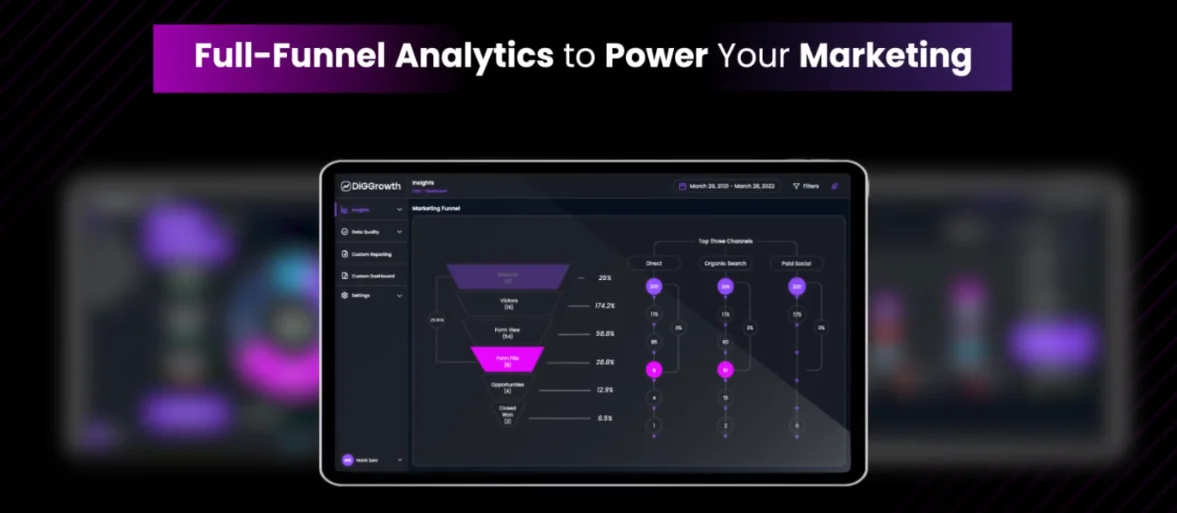
DiGGrowth is an AI-driven ABM platform that helps businesses prioritize accounts based on predictive insights. It tracks real-time engagement, intent signals, and behavioral data to refine targeting strategies.
Key Features:
- AI-powered intent analysis to identify active buyers.
- Lookalike modeling to discover new potential customers.
- Dynamic account scoring for real-time prioritization.
- Seamless integration with CRM and marketing tools.
2. 6sense

6sense uses predictive analytics and AI-driven insights to help marketing and sales teams focus on high-intent accounts. It provides a deep understanding of buyer behavior by analyzing online research patterns and engagement.
Key Features:
- Predictive modeling to forecast purchase intent.
- AI-driven segmentation for personalized targeting.
- Real-time engagement tracking for timely outreach.
- Integrations with major CRM and ABM platforms.
3. Demandbase
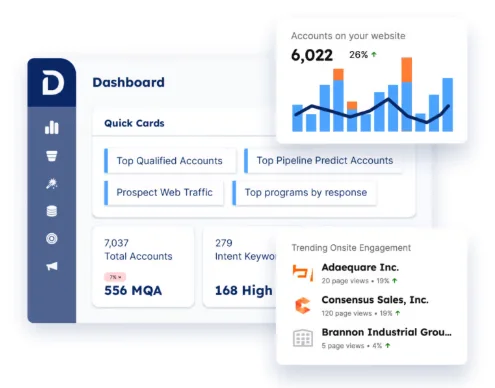
Demandbase leverages AI to analyze firmographic, technographic, and intent data for precise account targeting. It helps teams automate outreach and optimize account engagement strategies.
Key Features:
- AI-driven account insights to improve targeting accuracy.
- Automated personalization for multi-channel engagement.
- Predictive scoring to rank high-value prospects.
- Integration with Salesforce, HubSpot, and other marketing platforms.
4. Bombora
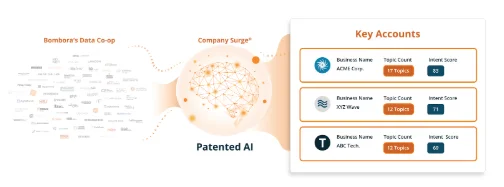
Bombora specializes in intent data tracking, enabling businesses to understand which accounts are actively researching their solutions. It provides AI-powered insights that help businesses engage potential buyers at the right time.
Key Features:
- AI-based tracking of buyer intent signals.
- Industry-specific insights for targeted campaigns.
- Automated account ranking for sales prioritization.
- CRM and ABM platform compatibility for seamless execution.
5. ZoomInfo

ZoomInfo combines AI-driven data enrichment with advanced prospecting to help businesses refine their ABM targeting. It offers deep insights into company firmographics, decision-makers, and engagement trends.
Key Features:
- AI-powered data intelligence for better prospecting.
- Predictive analytics to rank high-value accounts.
- Behavioral tracking to monitor buyer engagement.
- Integration with sales and marketing automation tools.
Integrating AI with Your Current ABM Strategy
AI should not function as an isolated tool but as an integral part of the ABM strategy. Here is how to ensure smooth integration:
- Align AI insights with sales workflows –
- Ensure marketing and sales teams have access to AI-generated insights –
- Automate AI-driven triggers –
- Continuously optimize targeting –
Sales teams should receive real-time updates on high-priority accounts and recommended engagement strategies.
AI should provide unified account intelligence, helping both teams collaborate on personalized outreach.
Use AI to automatically initiate personalized email campaigns, ad retargeting, or sales follow-ups when an account reaches a certain engagement threshold.
AI should not be a one-time setup; regularly review and refine AI-driven insights to improve accuracy.
Case Study: How DiGGrowth Helped a Renowned Finance Company Achieve Precision Targeting
A leading financial services company struggled with low engagement rates and inefficient ABM execution. Despite having a robust marketing team, they relied on static firmographic data, resulting in poor account prioritization and wasted sales efforts.
DiGGrowth implemented an AI-driven targeting solution that transformed their ABM strategy:
- AI identified high-intent accounts by analyzing behavioral signals, including search activity and content engagement.
- Predictive scoring ranked accounts based on their conversion likelihood, ensuring sales teams focused only on the most promising leads.
- Automated personalization tailored messaging based on real-time insights, increasing email open and response rates.
- Real-time adjustments refined targeting dynamically, ensuring continuous optimization of outreach efforts.
The results? A 40% increase in engagement rates, a 30% reduction in wasted marketing spend, and a significantly shorter sales cycle.
Key Takeaways
- AI-driven ABM enhances precision by identifying high-value accounts using real-time data, behavioral insights, and predictive analytics.
- Businesses leveraging AI see improved engagement, higher conversion rates, and faster sales cycles than traditional ABM methods.
- AI-powered platforms continuously adapt to shifting customer intent, ensuring marketing and sales teams focus on the most relevant opportunities.
- Automation and personalization enabled by AI improve outreach effectiveness, leading to deeper relationships and long-term customer value.
- Companies integrating AI into their ABM strategy gain a competitive edge, optimizing resources and driving measurable revenue growth.
Conclusion
AI-powered account targeting is no longer an option—it is necessary for businesses looking to stay ahead in B2B marketing. Traditional ABM methods lack the agility and precision to engage today’s fast-moving buyers. AI-driven insights empower marketing and sales teams to make data-backed decisions, refine their approach dynamically, and maximize ROI. As competition intensifies, companies that adopt AI in their ABM strategy will outperform those that rely on outdated targeting methods.
Want to transform your ABM strategy with AI?
Just write to us at info@diggrowth.com and we’ll get back to you.
Ready to get started?
Increase your marketing ROI by 30% with custom dashboards & reports that present a clear picture of marketing effectiveness
Start Free Trial
Experience Premium Marketing Analytics At Budget-Friendly Pricing.

Learn how you can accurately measure return on marketing investment.
Additional Resources
How Predictive AI Will Transform Paid Media Strategy in 2026
Paid media isn’t a channel game anymore, it’s...
Read full post postDon’t Let AI Break Your Brand: What Every CMO Should Know
AI isn’t just another marketing tool. It’s changing...
Read full post postFrom Demos to Deployment: Why MCP Is the Foundation of Agentic AI
A quiet revolution is unfolding in AI. And...
Read full post postFAQ's
AI provides real-time insights, ensuring both teams focus on high-priority accounts. It streamlines communication by offering predictive scoring, engagement tracking, and automated recommendations, aligning marketing efforts with sales priorities for better collaboration and efficiency.
AI can analyze even small datasets and integrate third-party intent data to refine targeting. It helps small businesses identify high-potential accounts, personalize outreach, and scale ABM strategies efficiently without needing extensive internal data.
Common challenges include poor data quality, integration complexities, and resistance to AI adoption. Ensuring clean, structured data, choosing the right AI tools, and training teams on AI-driven insights can help overcome these obstacles effectively.
AI-driven ABM platforms adhere to data privacy regulations using encrypted data, anonymized insights, and compliance with GDPR, CCPA, and other standards. Businesses should work with AI vendors that prioritize security and transparent data usage policies.
AI-driven targeting benefits industries with complex B2B sales cycles, including finance, healthcare, SaaS, manufacturing, and technology. It helps these industries identify intent-driven accounts, personalize messaging, and optimize resource allocation for higher conversion rates.
